Please be aware of our copyright notice. If you have a good reaon for using a photo from this site ask permission from first - it is frequently given.
Southern Signals
Semaphore Signals
| Shunt signals. |
| As was explained in the introduction, a shunt signal
only gives a driver permission to proceed as far as he can see the line is
clear. It does not tell him whether or not the road is clear to the next
signal (if there is one), so he has to be prepared to stop at any moment. This
is necessary as otherwise no movement could be made onto a line that is already
occupied. Just a couple of examples are where an engine runs round a train and
sets back onto the coaching stock (here the shunt signal is called a
'calling-on signal') or is moving on shed with another loco already
occupying the approach road. Such signals will be red and white ones, either a
white disc with a red stripe or a miniature semaphore arm which can have a
vertical or horizontal stripe, a ring or a letter according to the installation
and the local instructions for that Signalbox.
Such signals will also control movements over a crossover and into and out of sidings. Once inside the sidings, however, there is frequently no need for further signals. Sometimes the exit signal will be placed where it can only apply to the exit road and sometimes where it could be taken to apply to one or more other roads. In this latter case it was normal on the Southern to use a yellow dummy which was originally a yellow miniature arm with a black vertical stripe or in later years either that or a black disc with a yellow horizontal stripe. In either case the meaning is that the signal may be passed when "on" provided the movement is not in the direction to which the signal applies. |
| A very early Southern Railway shunt signal that was in use at
Sheffield Park on the Bluebell Railway. These arms were supplied by
Westinghouse and they were very easily converted once the Southern Railway
decided to standardize on disc signals although the miniature arms could still
be found well into the 1950s. Unfortunately this particular signal's age
was catching up with it so it has been replaced by a Westinghouse disc but will
be used again, when a more peaceful location is available!
photograph by Peter Richards |
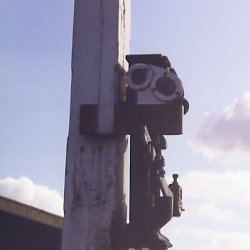 |
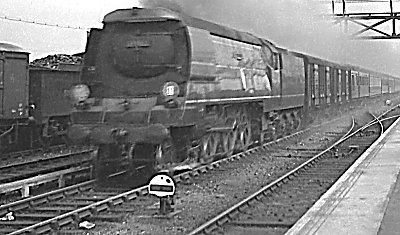 |
In this photograph the shunt signal, a Westinghouse disc controlling
movement is safely fixed at stop!
photograph: Mike Morant collection |
| The previously viewed shunt signal at Newhaven once more.
This is immediately recognizable as a Southern Westinghouse signal as the other
railways/regions used circular discs. This is not to say that there were no
round discs on the Southern, there were, but not in large numbers and mainly
after nationalization, though they featured in the L&SWR low pressure
pneumatic system. Note that the round discs had the lights on the left rather
than the right, as shown here. This signal also shows to good effect that the
proceed indication for after dark was shown by a blue, not a green, lens
because the oil lamp burns with a yellow flame, and as every schoolchild knows,
blue and yellow make green!
photograph by Glen Woods |
 |
 |
Left: Mounted on a standard Southern Railway rail-built post is this standard SR stop arm, but we are more interested in what is mounted beneath! Moving down the post the first thing to note is the white diamond that informs a driver the signal is exempt from Rule 55, then there are two shunt dummies. At first glance they appear standard Westinghouse ones, as used all over the Southern Railway/Region, but closer inspection shows they have no spectacles and are, in fact, illuminated dummies, but of the Westinghouse shape rather than the full circular shape seen in previous pages. Underneath the dummies are two arrows to indicate to which movement the dummy above it applies. At the time of the photograph the left dummy is "off", for a movement to the left. | 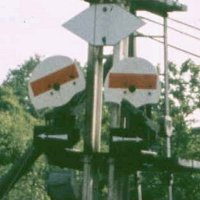 |
| Above: A close-up of the
dummies. The black hoods of the lamps that illuminate the dummies may just be made out above the boards carrying the arrows. Photograph taken at Ryde St Johns Road during May 1977 photograph by Clive Standen |
||
| Siting shunt signals on high was quite common where they
were used underneath running signals, but when on their own was nowhere near as
common as there really wasn't any need to do so unless sighting of the
signal was difficult. Where so positioned, they are referred to as elevated
shunt signals. On the right is a photograph of one that was at Tunbridge Wells
West, and was the inspiration for one installed on the Bluebell Railway where
an embankment would restrict the view of the signal were it to be placed at
ground level.
photograph by kind permission of Alan Elliott |
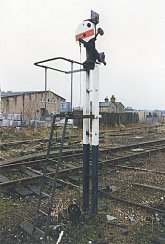 |
| The following front and rear views of a floodlit shunt disc, a yellow shunt signal disc, a yellow shunt arm and an animation of a yellow shunt signal disc are from photographs provided by Trevor Hurdle. Note that these do not contain the spectacle glass which is part of the post on which the discs/arms are mounted. |
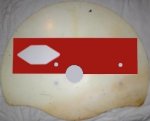 |
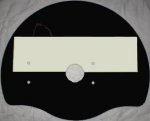 |
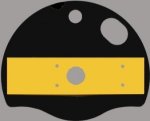 |
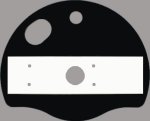 |
||||
| The white diamond on the front of the floodlit disc means that that particular signal was exempt from the provisions of Rule 55, most probably because it was situated beside a section of track-circuited line. | |||||||
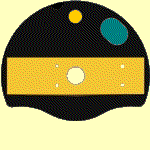 |
|||||||
| From the above images it can be seen that the fixing holes are the same on both the miniature arm and the disc, indicating how easily a disc could be substituted for a miniature arm. Look at the red miniature arm above to see how the spectacle plate had the aspects in the same place as the discs have. | |||||||
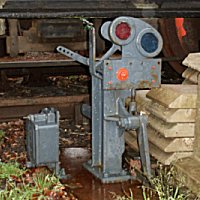 |
This is the basic post that can carry either a miniature arm or
a Westinghouse disc. Note the blue proceed spectacle glass which, when paired
with the yellow flame of an oil lamp shows a green light.
photograph by Peter Richards |
| Here is a modern example of a round dummy on the Southern.
This one, at Dorking, doesn't have the traditional lamp but is floodlit
from above therefore showing the whole disc after dark, not just a red or green
light. These discs were generally put in with colour-light signalling, though
in the pre-modernisation era only if a layout required drastic revision when
usually the existing mechanical signalling was replaced with a miniature
lever-frame working power points, colour-light signals and floodlit discs.
photograph by Nick Beck |
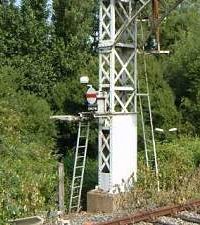 |
| Yellow Shunt signals. |
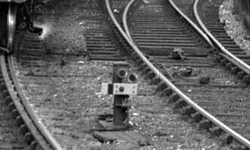 |
This is the best photo we have at present of a miniature arm
yellow shunt dummy - at Cowes, IoW. To make a movement towards the crossover
(left) a driver must first ensure the dummy is off. To make a movement straight
on, staying on the platform road, he does not need the dummy to be off.
photograph by Ron Hersey |
| An interesting signal at Chichester This is an elevated
yellow shunt signal with an almost full size arm. Note, however, that as it is
a shunt signal it doesn't have a fishtail end and has a straight black
vertical stripe. There were at least four other examples of a signal like this,
one at Mountfield sidings (just north of Battle), two at Fremington and one at
Ernesettle Sidings, near Bere Ferrers.
photograph by Trevor Tupper |
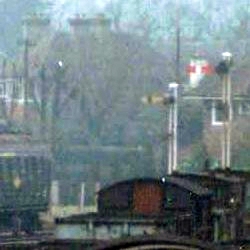 |
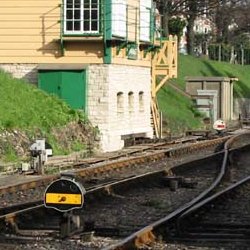 |
A yellow shunt dummy at Swanage. This is a standard Westinghouse dummy as
favoured by the Southern Railway and BR(S) and is the yellow equivalent of the
dummy, shown on a previous page, at Newhaven. Note that in the background is a
red dummy with the white "diamond" indicating that it is not subject
to the provisions of Rule 55.
photograph by Andy Vincent |
| A yellow shunt dummy at Salisbury. This one is a full round
disc, with the spectacle lenses on the left, and is one of a series that was
normally used in conjunction with the pneumatic signalling system. Most yellow
dummies were of the Westinghouse pattern, as in the red dummy above. However,
as these yellow disc signals were not introduced until the late 1920s, the
previously used miniature arms survived in considerable numbers, well into
British Railways days.
photograph by Clive Standen |
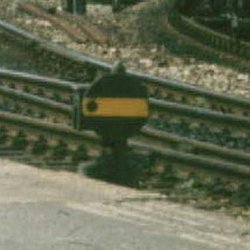 |
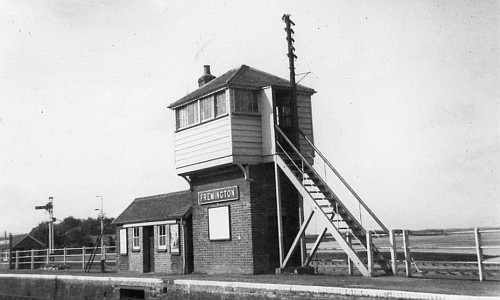 |
Only a black and white image, but this photograph quite clearly shows one
of the two full height yellow shunt signals at Fremington.
photograph by John Bradbeer |
| Pre-Grouping Shunt signals. |
| As was explained in the introduction, yellow signals
were first introduced in the late 1920s, so all shunt signals used by the
pre-grouping companies were "red" ones.
The SE&CR favoured miniature arms, although they also used revolving signals. These miniature arms, though, were quite different from those used by the Southern Railway, and shown on the previous page. They looked very "stubby" with the lamp and lenses in the middle of the arm. |
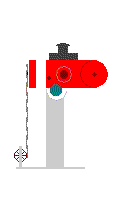 |
In this drawing on the left note that the pivot point is just to
the right of the white stripe and that the weight is an integral part of the
arm. The wire from the signal lever is attached to the chain on the left and
when the lever is pulled, pulls the arm down in a lower quadrant movement. To
replace the arm the large weight on the right hand end takes the arm back up to
the horizontal position as the lever is put back, thereby slackening the chain.
One of these signals can be seen at Haven Street on the Isle of Wight Railway. |
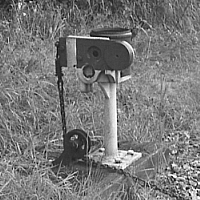 |
| The signal on the right was at Hawkhurst.
photograph by Chris Knowles-Thomas. |
| The LB&SCR used a revolving signal. This revolving signal showed a red face, with a red light in the centre, towards the driver and, additionally, had a white "hand" arrow indicating the road it controlled. The whole of the body of this signal, including the oil lamp, rotated through 90° to show a green face with a white cross and green light to the driver for the proceed with caution aspect. The photographs below are of one of these signals that was in use at Sheffield Park on the Bluebell Railway. Unfortunately its age was showing and it has been replaced by a standard Westinghouse disc although it is planned that it should be returned to use again somewhere where it will not be used very much! Unfortunately the photograph of the stop aspect of this signal has been mislaid, so what is reproduced here is an image that was reduced and cropped for printing purposes. |
 Left: LB&SCR revolving signal showing the stop aspect.
The white hand indicates which road is controlled by this signal.
Left: LB&SCR revolving signal showing the stop aspect.
The white hand indicates which road is controlled by this signal.
Right: This signal's proceed with caution aspect. Please note that both these photographs were taken when the signal was "on", so this second one is the side view! photographs by Peter Richards Far Right: Another LB&SCR revolving dummy in the "on" position, this time with the hand pointing to the left. photograph: Mike Morant collection |
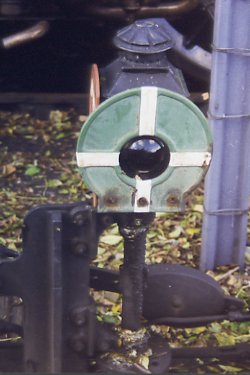 |
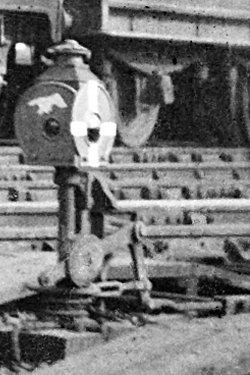 |
| The L&SWR used a totally different shunt signal from any of those already mentioned. Supplied by Stevens & Co it was known as a Pillar, or Flap, signal. The original design was very simple with the flap, painted red for the stop aspect and including a large red spectacle glass, dropping down to reveal a white light (actually yellow due to the flame) for the proceed with caution aspect. However the red glass was susceptible to damage and if it fell out then there was a risk of a false 'proceed' indication, so in due course the design was altered. The red glass was omitted and a smaller red/green aspect (using blue glass) spectacle plate, which moved as the flap was lowered or raised, was provided between the flap and the signal light. Used throughout the L&SWR, and also on the S&DJR, examples of these signals lasted into the 1950s. |
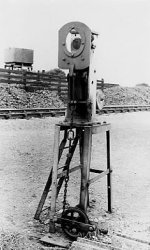 |
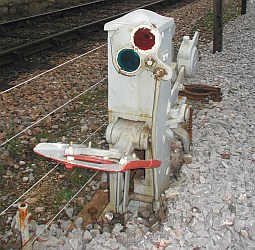 |
|
| An elevated "flap" signal of the type
used all over the former L&SWR lines, although this was photographed at
Bridgwater (North), on the S&DJR route, in 1952. The "flap" falls
forward through 90° to reveal a green aspect.
photograph: Chris Osment collection |
The modified version showing the spectacle plate
mounted between the flap and the signal light.
photograph by Chris Osment |
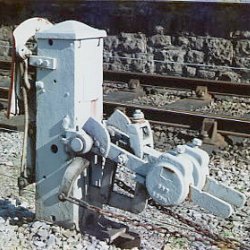 |
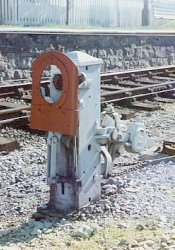 |
| This second signal was also on the S&DJR at
Highbridge but is seen here as re-erected at the S&DJR museum at Washford
on the West Somerset Railway. An unusual feature of this signal is it was
"slotted", hence the two balance levers. "Slotted" signals
had to be pulled off by two levers, either in separate Signalboxes or in a
Signalbox and a ground frame, though putting back just one of the levers would
reset the signal to stop.
photographs by Chris Osment |
|
Index to pages
This page was last updated 2 January 2011